Read Reviews
The Best Wall Mounted Washing Lines
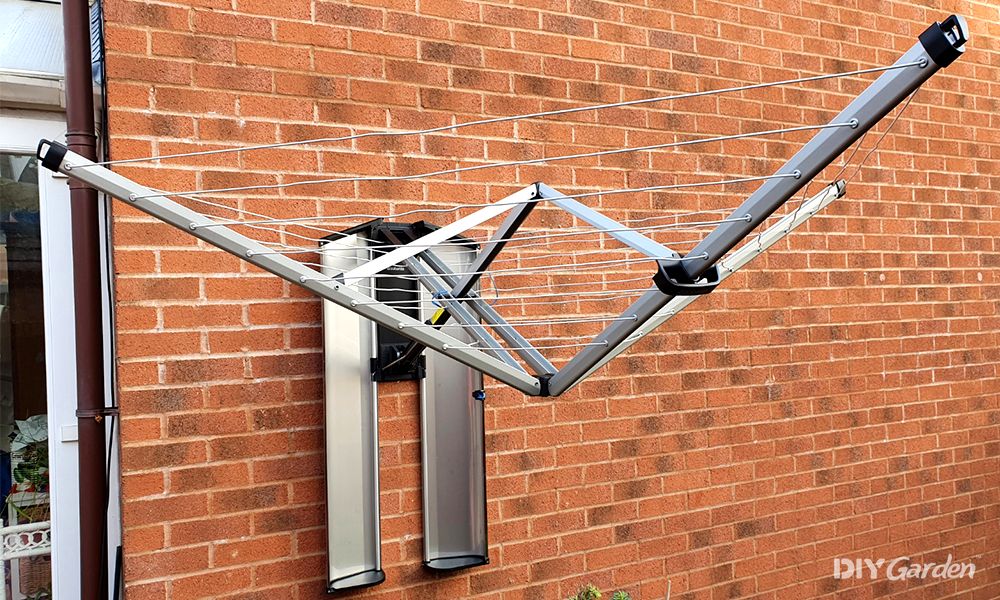
-
Brabantia WallFix Retractable Washing Line
-
Denny International Wall Mounted Washing Line
-
ASAB Retractable Wall Mounted Washing Line
-
Oypla Folding Wall Mounted Washing Line
-
Wilsons Direct Outdoor Wall Mounted Dryer
Wall Mounted Washing Line Reviews
- Stainless steel storage case both protects the line and hides it from view when not in use
- Installation can take as little as 30 minutes
- Ideal for small gardens as it only protrudes 15 cm from the wall when closed
- 20 kg weight capacity (equates to two loads of washing)
- 120 cm width between arms means it's possible to hang sheets
- How to close the line isn't clear in the instructions, pushing it up and then in usually does the trick
- Overloading a certain area may cause the arms to bend
- Quite expensive compared to a lot of standard wall mounted lines
- Design
- 5
- Ease of Assembly
- 4.8
- Ease of Use
- 4.5
- Value for Money
- 4.8
Dutch homewares giant Brabantia have more than a century of experience making clever and stylish homewares. Their motto is “Designed for Living”, and after testing out their WallFix retractable washing line, I think I agree!
Drying your washing outside is about as basic as it gets, but it saves you energy, money, and even helps the planet. But what if you haven’t got room for a rotary washing line, or you simply don’t want to look at one when it’s not being used?
In steps Brabantia’s wall mounted washing line. It bolts to the wall and folds out from its stainless steel protective case when you need it. And if you need that bit of your garden back, simply fold it away and forget about it.
I didn’t know that the humble washing line had much room for improvement, but Brabantia have proven me wrong. I’m not going to be turning on the tumble dryer any time soon. This is a brilliant clothes drying solution for anyone who doesn’t have a whole lot of space.
Did you find this review helpful?
- Value for money - reasonable size without being too expensive
- Very lightweight which is useful for assembly
- Assembly is easy and takes around 15 minutes
- Held in place with four screws which means it’s not impossible to remove from the wall if necessary (e.g., can be taken down over winter)
- Low weight capacity of 7 kg - only suitable for one load of washing at a time
- Needs to be used carefully - overloading the line/one side may cause the arms to bend
- Included screws are relatively short
- Design
- 3.5
- Ease of Assembly
- 5
- Ease of Use
- 5
- Value for Money
- 5
A good choice for individuals/couples, this Denny International Wall Mounted Washing Line is a good value line with a reasonable amount of hanging space. It’s approximately 180 x 180 cm when opened, and folds away easily.
Fitted with 26 metres of line, the Denny International is big enough to hold a full load of washing. However, as is often the case with these more budget-friendly options, it’s unlikely to be able to support the weight of a lot of heavy items, like wet towels. The maximum weight capacity is approximately 7 kg, and you should be careful to spread the weight evenly across the whole line.
The frame itself is made from aluminium, it’s lightweight and easy to manage during assembly – putting up the line will take less than half an hour. Due to its aluminium construction, as well as the screws included, it’s important not to overload this line. As mentioned, it’s suitable for smaller amounts of washing, but is likely to struggle under a lot of weight.
Overall, this washing line is compact and easy to store away. When not in use, it folds back towards the wall to save space. Opening and folding can be done using one hand, leaving the other free to hold onto the laundry basket.
Due to its size and capacity, this is one of the best wall mounted washing lines for individuals or couples. Although it’s not the strongest of lines, it will cope with smaller loads of washing and still offers a very useful space-saving solution to drying clothes without costing a lot of money.
Did you find this review helpful?
- Only protrudes approximately 15 cm from the wall
- Holds approximately one load of washing (and maybe a bit more)
- Assembly take less than 30 minutes
- A great value washing line considering size, quality and price
- May not remain sturdy if used in strong winds
- Some people have purchased separate screws as the ones included are a little short
- May struggle to support large, wet items like bath towels
- Design
- 5
- Ease of Assembly
- 4
- Ease of Use
- 4.5
- Value for Money
- 5
Offering excellent value for money, this ASAB Retractable Wall Mounted Washing Line strikes a good balance between size, quality and price. It is approximately 170 cm wide, threaded with 26 m of PVC-coated washing line, and could be fitted into a passageway down the side of the house, or in a narrow lobby area, to really keep it out the way.
This washing line is relatively simple to assemble and install. It comes with four screws, as well as the plugs required to secure it to the wall; nevertheless, some customers have reported that they preferred to use their own screws – the ones supplied with the line are a little short.
Thanks to its aluminium frame, this line is very lightweight; at just 1.9 kg, it’s easy to hold and support during installation. Although aluminium has the advantage of not rusting, it doesn’t have the strength of steel; therefore, you do need to take care not to overload this line.
It can support approximately 8 kg of washing, which is approximately one small load. It may be able to withstand slightly more if the items are small and evenly distributed.
Overall, this is a great option for those who lack space in their garden or home, as it pushes back to approximately 15 cm when retracted. It’s one of the best wall mounted washing lines to buy if you’re after value for money – the line works well and can be very effective, you just need to make sure not to overload it.
It also comes with a cover included to keep it neat, tidy and protected from the elements when not in use.
Did you find this review helpful?
- Higher weight capacity than others on the market at 10 kg
- Holds approximately two loads of washing
- Compact size when extended (128 x 128 cm) so suitable for smaller spaces
- Folds away very easily with minimal physical strength required
- Does not rust easily
- Not strong enough to hold multiple heavier items such as wet towels, jeans or bedding
- Shouldn’t be used in windy weather as this can put too much pressure on the aluminium frame
- No cover included to keep line clean when folded away
- Design
- 4
- Ease of Assembly
- 5
- Ease of Use
- 4
- Value for Money
- 5
As the line with the second-highest weight capacity featured here, the Oypla Folding Wall Mounted Washing Line can hold approximately 10 kg of washing. It’s therefore a better choice for families than the Denny or ASAB lines (and a good option if the Brabantia line is just too expensive).
When open, this four-armed washing line measures approximately 128 x 128 cm, so it’s also the most compact of the products featured on this page. As a result, it’s suitable for areas that are particularly tight on space, whether that’s laundry rooms, passageways, balconies or patios.
This washing line has a lightweight aluminium construction, and 27 metres of strong PVC line. It folds back neatly against the wall when not in use, taking up little space and therefore not getting in the way unnecessarily.
One downside of this line is that it’s not very stable in strong winds. Due to its aluminium construction, the arms can bend if they are overloaded and/or subjected to other forces – such as wind. Because of this, it’s best not to use this line if there is more than a slight breeze.
Given that this is such a compact line, with quite a large weight capacity, it does still offer good value for money, you just need to take care of it so that it will last. Nevertheless, it’s still inexpensive when compared to the premium Brabantia line.
All things considered, it’s one of the best wall mounted washing lines if you want something larger, that will hold approximately two loads of washing, whilst still getting value for money.
Did you find this review helpful?
- Suitable for smaller households with enough drying space for one full load
- Easy to open and close
- Compact and unobtrusive when closed - doesn't take up a lot of space when closed
- Frame unlikely to cope with a lot of heavier loads - best for light items
- No cover included which would help keep the unit dry and the lines clean
- High winds may cause damage to the frame, especially if it is left open
- Design
- 4
- Ease of Assembly
- 4
- Ease of Use
- 4
- Value for Money
- 4.5
A good budget option if you’re just after a simple, retractable washing line, this Wilsons Direct Outdoor Wall Mounted Dryer is inexpensive and offers 26 metres of drying space.
As a cheaper option, it doesn’t have the same quality as the Brabantia wall mounted line, but then again it doesn’t have the high price tag either.
This line is made from rust-resistant aluminium, and measures approximately 170 x 170 cm when extended. It folds back against the wall, but doesn’t have a cover or storage unit to conceal it.
It’s best used for hanging out lighter items, and can fit at least one load of washing with space left over. However; it shouldn’t be overburdened because the aluminium frame may not withstand heavier weights well.
Whilst an advantage of aluminium is that it can be left outside without rusting, a downside is that it’s not as strong as steel.
Nevertheless, this washing line can still be a useful addition to small gardens, and is a neat laundry solution for balconies and flats as well.
The overall consensus seems to be that this wall mounted drier will do the job, but isn’t as high quality as some of the more expensive models on the market. This makes sense, considering its lower price, and it’s one of the best wall mounted washing lines if you’re on a budget.
It still offers a practical solution for those with smaller spaces that don’t want to spend a lot of money.
Did you find this review helpful?
Product Tester
I did hours of research and testing to find you the best wall-mounted washing lines you can buy. I thoroughly compared each model’s overall design, how easy it was to assemble, its ease of use, and the value for the money spent, examining both budget and more expensive models to fit anyone’s budget. Here are the factors I considered when testing those elements:
- Design: For the overall design, I looked at how well the washing line was made and what materials it was made from, how good the screws were for mounting it, and how compact it was for small spaces when open – products with stainless steel or brushed aluminium coating and screws were given the best rating as these materials are the most durable and weather-resistant. Washing lines that came with a protective cover were also rated higher as this significantly improved their lifespan. I looked at whether it could be folded away when not in use and how far it sticks out from the wall when folded so that you can get extra space in your garden if you need it. Another important consideration was how much total weight each washing line could hold before bending; those that could hold two loads of washing got a higher rating, while those prone to bending under the weight of one load got a lower rating.
- Ease of Assembly: I examined how fast the washing lines were to set up, and those that went up easily in less than 30 minutes got good ratings. I also rated them on how clear the instructions were on setting it up and how to close the compact models when not in use; if they needed to be clearer, they got a lower rating.
- Ease of Use: I studied how well each product held the laundry and whether or not you had to be careful to space the washing out evenly so it would not bend under the weight. I looked at how well it held large items like sheets and heavy items like jeans or towels. I also looked at how easy it was to open and close the washing line when not in use. Finally, I considered how it would stand up to use in winds – if you had to be careful not to use it on a windy day, it got a lower rating.
- Value for Money: To determine the value for the money spent, I looked at how much the unit cost compared to how well it was made and how well it balanced size, quality, and price. I also factored in what size family or household it would suit. Even though budget models did not hold as much laundry, I considered the value for the price since some people need a budget line.
How to Choose The Best Wall Mounted Washing Line
A lack of space for drying clothes is a common problem.
If you don’t want to take up room outside with a large washing line, but want a solution that is easier than using a collapsible airer, a wall mounted washing line can provide a simple solution.
These retractable lines save space, by folding up against the wall when not in use, and are simple to pull out and use when required.
They can also be used both inside and out.
If you think a wall mounted line sounds like a good idea, have a read of the following information to make sure you get one that will work well in the space you have available:
How Much Washing Can it Hold?
The amount of drying space is usually measured in metres, and on top of this most washing lines will also have a weight capacity. If you are drying a lot of heavier items such as wet towels or jeans, you’ll need to pay more attention to the weight capacity.
All the washing lines featured on this page have around 24 – 26 m of drying space. Around 24 metres of drying space is relatively standard for wall mounted lines and is enough to hold one large load of washing, or two smaller loads.
Wall mounted washing lines are unlikely to have as much drying space as rotary lines, and are therefore better suited to smaller families.
These washing lines can differ in size between models, even if they have the same amount of line in metres. Whilst getting the largest option may seem like a good idea for hanging out the most washing, it also depends what size space you’re working with.
Larger wall mounted lines can measure approximately 120 cm per side. It will be easier to hang out sheets on these lines, as they will fit better. However, the line will protrude out further than a smaller line with sides that measure 100 cm.
If you don’t have a lot of room, you need to consider how much space the extended line will take up, as well as the type of washing you want to hang out. Often a compromise can be made by hanging larger items, like sheets and towels, elsewhere – on an airer or over banisters.
READ NEXT: The UK’s Best Rotary Washing Line
Fixing a Wall Mounted Line to a Wall
Usually, fixing a retractable wall mounted line to a wall outside with involve drilling through brick.
Make sure that you’re comfortable and safe with using the tools required to do this, and always get a professional to help if not.
Whenever drilling through walls, you must also make sure that you’re not in danger of drilling through any pipes, electrics, or important infrastructure as well.
To fix a wall mounted line to the wall, you first need to make sure that there is enough space for the line. When it is open, you don’t want it to extend so far that it interferes with anything on the wall, or in front of the wall. Before purchasing a wall mounted line, take note of its size dimensions and measure them out on the wall to check that there’s enough space.
Here’s a general guide for fitting a wall mounted line, but check the manufacturer’s instructions with the model you buy as they may differ:
- Take the wall bracket and mark on the wall with a pencil where you want it to go. Use a spirit level to make sure the position is straight. In terms of height, you can position the washing line wherever you want depending on how tall you are and how easy it will be to reach. Positioning the lower part of the bracket at approximately 120-150 cm should keep washing off the ground. A good rule of thumb is that the top of the line should be approx. 10 cm above the primary user’s head.
- Make sure to mark the mounting holes of the bracket with a pencil.
- Using a masonry drill and 8 mm drill bit, drill pilot holes where the mounting holes are marked out. Wear protective gear when drilling into bricks including goggles, a face mask, and gloves.
- Fix brackets to the wall with screw bolts. Use an impact driver to push the bolts into the pilot holes.
- Using the provided screws and fittings, fit the frame of the washing line to the bracket.
Other Styles of Wall Mounted Line
As mentioned in the introduction, there are a few different types of wall mounted line.
The three main styles are:
- Retractable washing lines
- Single-level airers that fold flat against the wall
- Single-level airers that remain permanently extended (and can’t fold flat)
Naturally, there are pros and cons to each style.
Airers that retract, collapse, or fold up will naturally save space. Anything that doesn’t fold up may get in the way when not in use, especially if installed in a narrower alley alongside the house.
However, due to their collapsible nature, foldable lines are often made from lightweight aluminium. This is because lighter materials put less strain on the overall frame. Aluminium is rust-resistant, which is good news for lines that are kept outside, but it can still corrode and isn’t as strong as steel.
Lines that don’t need to collapse down are more likely to be made from steel. Also, because static lines don’t have any moving parts, they are generally stronger than foldable lines and can take more weight. Stainless steel shouldn’t rust easily, but anything made from standard steel will be prone to rust.
Wall Mounted Washing Line FAQs
Wall mounted washing lines should be installed on a strong wall and, if outside, they should ideally be in a spot that sees a lot of sun. Try to avoid very exposed areas. Remember that the screws you need will vary depending on the type of wall you are installing it on.
You should also ensure you have enough space to hang your washing. Not only should you have ample space to pull the washing line outwards, there should be space for you to stand to hang your clothes. Try to avoid installing it too close to your garden furniture or other obstacles that you’ll need to navigate if you are taking your washing down in a hurry!
You should also think about distance from the washing machine. No one wants to carry load after load of heavy wet clothing to a washing line that’s too far away.
Washing lines that are too low can be intrusive, while those that are too high are very difficult to use. The general rule of thumb is that the washing line should be installed up to 10 cm higher than the primary user’s head.
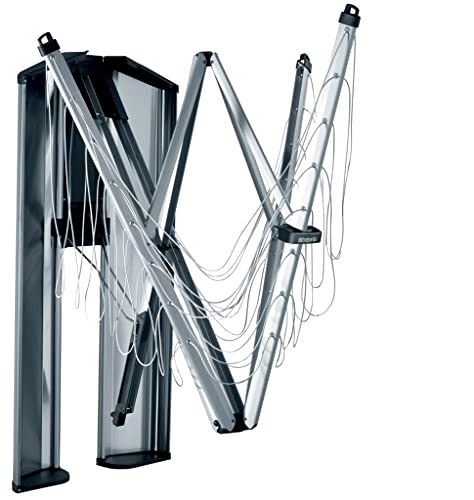
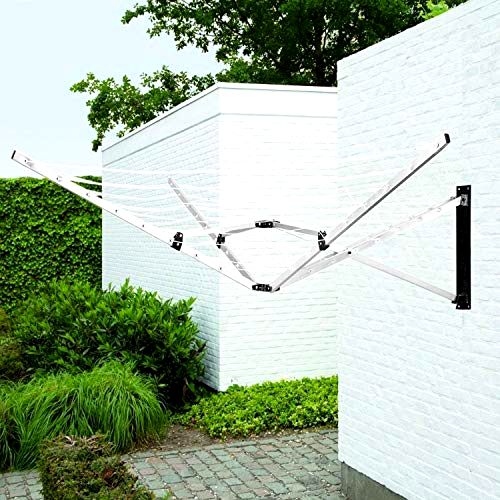
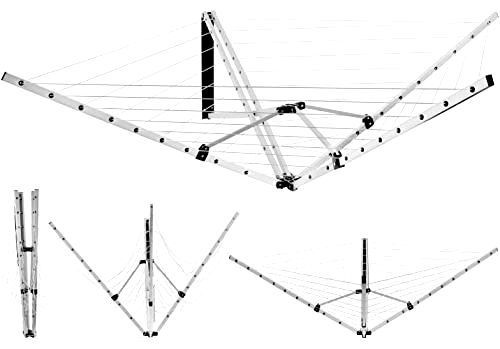
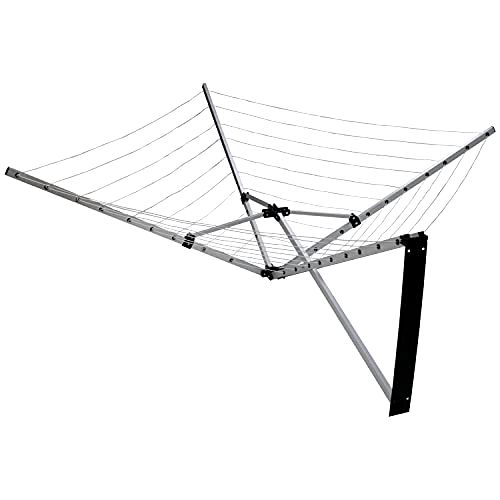
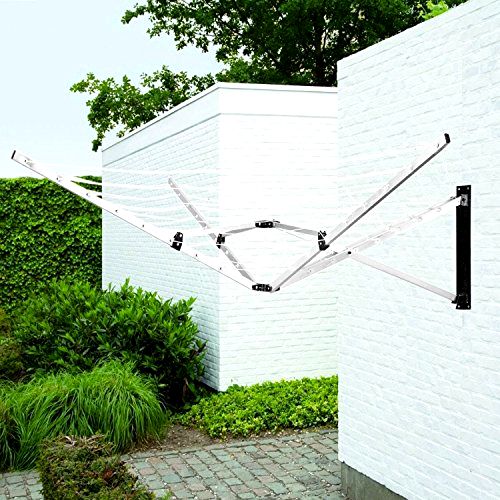
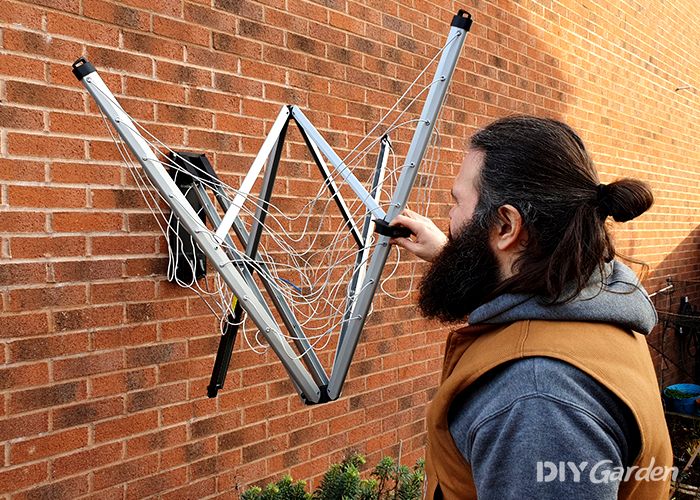

Share